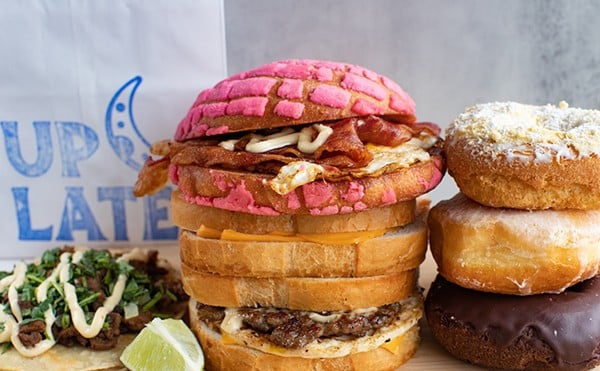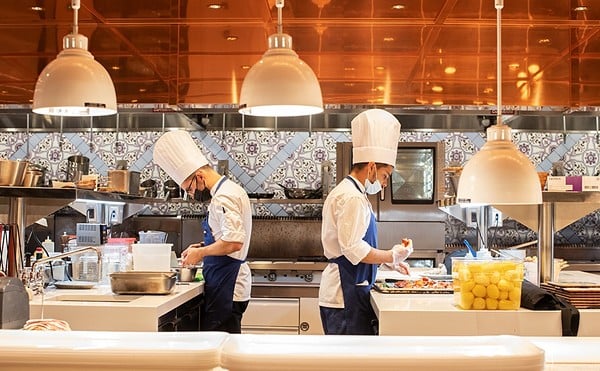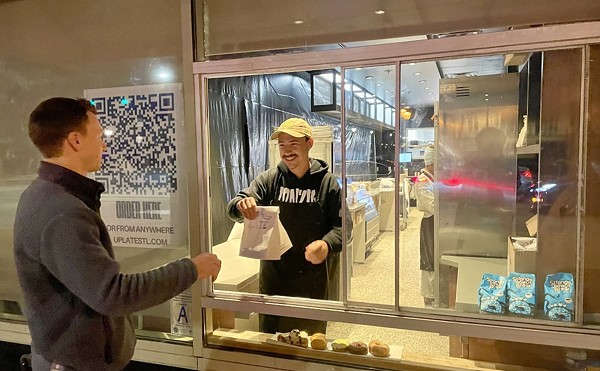That Saturday night, three friends and I had dinner at Maggiano's, which was really supper, because when I called to make the reservation (immediately after leaving the Wednesday lunch), the woman who answered the phone said, "If you're thinking of eating anytime between 5:15 and 8:45, we're completely booked." So I agreed to a nine o'clock seating, and this time our waiter told us, "We're known for leftovers. I've never spent so much time boxing stuff."
I missed the sit-down shtick at my third meal, another weekday lunch, but the woman I was meeting there filled me in. The waitress, after asking my companion if she'd ever eaten at Maggiano's before (a common thread at the start of every visit), said that the original Maggiano's opened in New York City's Little Italy in 1939. Not true. Maggiano's Little Italy, which opened its first Missouri location in Richmond Heights earlier this fall, was founded in Chicago in 1991 by the restaurant group Lettuce Entertain You, which today owns 31 casual and fine-dining chains, some Windy City-centric, others of national scope, including Big Bowl, Scoozi! and R.J. Grunts.
Such misinformation didn't surprise my lunch guest, Kathryn E. Kuhn, the chair of the sociology and criminal justice department at Saint Louis University. It's why she commented, soon after I sat down, that Maggiano's "bespeaks tradition without really being traditional." Well, that, and the restaurant's décor. The walls are littered here and there with black-and-white, old-timey photographs of people who look like they just got off the boat at Ellis Island. The soaring, two-story interior boasts glossy dark-wood fixtures that appear mahogany, but judging by the underside of the tables and the few scratches I noticed in one of the restroom stalls, they're stained that way, with cheaper, blonder wood underneath.
On Thursday, Friday and Saturday nights, a man in a tuxedo carrying a wireless microphone strolls about the bar area crooning Sinatra tunes and the like; actual recordings of Ol' Blue Eyes (and a couple other big-band singers, like Tony Bennett) are piped through the dining hall and bathrooms, and out onto the sidewalk in front of the restaurant. "This place oozes power," Kuhn said. "I'd expect there to be a hit in one of the booths, like something out of The Godfather."
What's most apropos about the cinematic reference is that Maggiano's Little Italy was built from the ground up earlier this year as a component of The Boulevard St. Louis, a shopping/dining/living "urban village" that, quite frankly, resembles a Hollywood backlot.
Planned developments like The Boulevard are a relatively new phenomenon in American society (an extension of the McMansion craze, I'm inclined to believe), but usually they're plunked down in rural environs where land is cheap, plentiful and near said McMansion subdivisions. They're typically not push-pinned into already crowded, heavily commercial zones, as The Boulevard is here.
Designed around a faux downtown Main Street, The Boulevard comes complete with cobblestones, gaslight-style streetlamps, apartments and condos located above retailers such as Ann Taylor Loft and Omaha Steaks — even a friendly neighborhood crossing guard to help visitors navigate the intersection of Main Street and the parking-garage exit. (There is minimal parking on the "street.") Kuhn aptly described it as "like the Galleria with weather."
Blazoned across the side of Maggiano's ubiquitous doggie bags — sturdy and handsome, like the Bloomingdale's Little Brown Bag, the nicest doggie bags ever — it reads, "Maggiano's Proudly Serves Barilla Pasta." Why on earth are hundreds upon hundreds of well-to-do west-county baby boomers cascading into a restaurant, one with no local reputation heretofore, and ponying up their hard-earned dollars for oversize bowls of supermarket pasta that must be consumed amid a deafening roar? Especially when better restaurants like Limoncello and Trattoria Branica, just as tony and well-turned-out and new, exist a couple miles away?
I had no idea, which is why I invited the big guns — i.e., the sociologist — to lunch.
"It's conspicuous consumption," Kuhn says. "It's that exclusivity of 'Can you get in?' The word is probably getting out about this place in the downtown Clayton office buildings" — Maggiano's has invested in virtually no local advertising so far — "and it's a chance for the well-to-do to show off how they've made it. It's the just-world philosophy: If I'm rich it's because I deserve to be, and if you're waiting on me, it's because you deserve to be. This place is the ultimate capitalist tool, for a Marxist."
Maggiano's serves its lunches and dinners either à la carte or "family style," with platters of appetizers, salads, pastas and entrées meant for sharing. (Funny how most establishments that serve Italian family-style meals are hardly ever owned and operated by actual Italian families.) The menu is ridiculously large — twenty-eight entrées and sixteen pastas to choose from — and so are the portions, hence all those doggie bags.
I rather enjoyed the yummy Italian sausage sandwich I ordered for lunch that day with Kuhn, sweet links and sauce accompanied by melted provolone and sautéed peppers and onions on a toasted onion roll. Kuhn soon realized, though, that she'd made a mistake choosing angel hair pasta in "Coach Joey Z's Pomodoro Sauce," which carried an afterburn of pure, overgarlicked beesting.
I'd been disappointed by a couple of Maggiano's pasta selections before: the spinach-and-chicken manicotti was a huge letdown, saddled with some sort of burnt, congealed cheese on top that obliterated the soft, more delicate ricotta inside. There was also too much spinach and hardly any sign of chicken. Just seeing manicotti on the menu of an Italian restaurant (mom-and-pop or corporate-owned) was a treat, since it so rarely makes such appearances, but I should've known to brace myself when my waiter didn't recognize my ethnic pronunciation of the dish. (It's manna-got.)
Maggiano's gnocchi, which I tried at the Saturday-night dinner, is the most unappealing plate of gnocchi I've ever encountered. Even for gnocchi, these dumplings were too doughy; there's no need for the pasta to glom onto the caps of one's molars like that. Its tomato-vodka sauce was uninspired, and the dumplings themselves looked a lot like, I'm sorry, that bug that crawled into Chekov's ear in Star Trek: The Wrath of Khan.
As Kuhn and I noted at lunch, there are some good reasons to dine at Maggiano's: It's centrally located to other businesses, it can accommodate large groups, and its valet parking, elevator access to the second floor, and attentive service make it user-friendly for older clientele.
Likewise, Maggiano's does do some menu items quite well. Zuppa di pesce showcased a wonderful, bounteous collection of salmon, calamari and baby octopus in a just-thick-enough tomato broth, while a chopped salad proved a diced-up, lip-smacking good time, with everything from scallions to avocados to blue cheese and prosciutto invited to the party. Eggplant mostaccioli was sweet and creamy, while farfalle with chicken, asparagus and spinach touched by a light Parmesan broth was sprightly. Bruschetta boasted tomatoes that tasted like a summer's day, which harmonized fantastically with pesto, Parmesan, roasted garlic and balsamic vinegar. The spumoni was dynamite.
Overwhelmingly, though, the food is what it is. Mozzarella marinara: a lukewarm brick of breaded and fried cheese centered on a plate of marinara. Caesar salad: a tasty-if-tepid tossing of chopped romaine and burnt-tasting croutons that doesn't even make an attempt at adding anchovies. Beef medallions: overcooked cuts of beef that were rather blunt and heavy, though offset by a nice helping of plump portabellas. Profiteroles: lumps of vanilla ice cream between cushions of pastry, with sadly little chocolate sauce to bring the whole thing together.
When I left Maggiano's after my last lunch, I noticed a banner alongside one of The Boulevard's buildings advertising an upcoming exhibit of Titanic artifacts at the St. Louis Science Center. It made me chuckle to myself for two reasons. One, I can't help but think that the kitchen staff at this mega-dining factory must toil and sweat much like the coal shovelers did in the bowels of that doomed boat. Second, I misread the sign at first glance. Instead of "artifacts," I thought it said "artifice."





